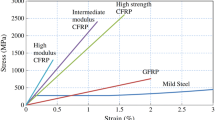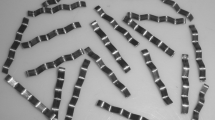Abstract
This paper investigates the ultimate strength behaviours of the unbonded prestressed concrete (PC) beams at cryogenic temperatures that aims to promote the applications of PC structures in cryogenic environments. Nineteen unbonded PC beams with different tension control stresses (0.4, 0.6, 0.75f ptk) were tested at 20, −40, −70 and −100 °C. The structural performances of the unbonded prestressed reinforced concrete (RC) beams under cryogenic temperature were reported that included general load–deflection behaviours, ultimate resistances, and failure modes. The test results indicated that at cryogenic temperatures, the plane section assumption for the prestressed RC beams under bending still worked, and the appearance of cracks can still be delayed by prestressing. The resistances corresponding to crack initiation, the yield of the non-prestressed tensile reinforcements and the ultimate failure of the beams all increased linearly with the decrease of the temperature. The stiffness of specimens also increased as the temperature dropped. Analytical methods for predicting the resistance corresponding to the crack initiation and the ultimate resistance at low temperatures were developed and compared with the test results.







Similar content being viewed by others
Abbreviations
- T :
-
Temperature
- W 0 :
-
Sectional resistance moment
- I n :
-
Moment of inertia of gross section about centroidal axis
- A n :
-
Gross area of concrete section
- A p, A s, \(A_{\rm s}^{\prime}\) :
-
Area of the prestressed strand, nonprestressed longitudinal tension reinforcements and compression reinforcements, respectively
- A v :
-
Area of stirrup within spacing s
- s :
-
Center-to-center spacing of the stirrups
- y n :
-
Distance from extreme tensile fiber to centroidal axis
- e pn :
-
Distance from centroid axis to centroid of prestressed strand
- \(a_{\rm s}^{\prime},\) a p :
-
Distance from extreme compression fiber to centroid of longitudinal compression reinforcements and prestressed strand, respectively
- h 0 :
-
Distance from extreme compression fiber to centroid of nonprestressed longitudinal tension reinforcements
- b :
-
Width of the concrete cross section
- x :
-
Height of the equivalent rectangular concrete compressive stress block
- f ptk :
-
Characteristic value of the tensile strength of the prestressed strand
- f cu :
-
Cubic compressive strength of concrete
- f t, f t,T :
-
Tensile strength of concrete at ambient temperature and at T °C, respectively
- \(f_{\rm c}^{\prime},\,f_{{\rm c},{\rm T}}^{\prime}\) :
-
Compressive strength of concrete cylinder at ambient temperature and at T °C, respectively
- f y, f y,T :
-
Yield strength of the nonprestressed tension reinforcements at ambient temperature and T °C, respectively
- \(f_{\rm y}^{\prime},\,f_{{\rm y},{\rm T}}^{\prime}\) :
-
Yield strength of the compression reinforcements at ambient temperature and at T °C, respectively
- f yv, f yv,T :
-
Yield strength of the stirrup at ambient temperature and at T °C, respectively
- σ con :
-
Tension control stress of prestressed strand
- σ pc :
-
Compressive stress of the concrete on the tensile edge of the beam caused by the effective stress in prestressed strand
- σ pe :
-
Effective stress in prestressed strand before the tests
- σ p :
-
Stress in the prestressed strand in the ultimate limit state
- γ :
-
Reduction factor for W 0 considering the plastic adaption of concrete
- R 2 :
-
Index for the ultimate strength of the beam
- M cr :
-
Bending moment corresponding to the crack initiation
- P cr, P cr1, P cr2 :
-
Resistance corresponding to the crack initiation from the test results, predicted by the first and second method, respectively
- V c, V s :
-
Transverse shear resistance contributed by the concrete and the stirrups, respectively
- V t, V T :
-
Shear force acted on the critical section of the beam and predicted transverse shear resistance
- M ut, M u,T :
-
Bending moment acted on the critical section of the beam and predicted flexural resistance
- PCS:
-
Prestressed concrete structure
- RC:
-
Reinforced concrete
- PC:
-
Prestressed concrete
- LNG:
-
Liquid natural gas
- LVDT:
-
Linear varying displacement transducer
References
Du JS, Francis TK, Enoch KH, Liu L (2016) Deflection of unbonded partially prestressed concrete continuous beams. Eng Struct 118:89–96
Koh T, Bae Y, Shin M, Hwang S (2016) Experimental study on transfer length of an eco-friendly prestressed concrete sleeper. Constr Build Mater 109:25–33
Qiao Y, Wang HF, Cai LC, Zhang W, Yang BH (2016) Influence of low temperature on dynamic behavior of concrete. Constr Build Mater 115:214–220
Yan JB, Liew JYR, Zhang MH, Wang JY (2014) Mechanical properties of normal strength mild steel and high strength steel S690 in low temperature relevant to Arctic environment. Mater Des 61:150–159
Gautier DL, Bird KJ, Charpentier RR et al (2009) Assessment of undiscovered oil and gas in the Arctic. Science 324(5931):1175–1179
Reginald BK, Srinath RI, Zachary CG, Syeda R, Eyad AM, Dan GZ (2014) Relating damage evolution of concrete cooled to cryogenic temperatures to permeability. Cryogenics 64:21–28
Xie J, Li JJ (2013) Thermal-structural coupling analysis of LNG tanks in cryogenic temperature. Spec Struct 30(1):44–47
Reginald BK, Srinath RI, Zachary CG, Eyad AM, Dan GZ (2013) A review of concrete properties at cryogenic temperatures: towards direct LNG containment. Constr Build Mater 47:760–770
Xie J, Li XM, Wu HH (2014) Experimental study on the axial-compression performance of concrete at cryogenic temperatures. Constr Build Mater 72:380–388
Rostasy FS, Schneider U, Wiedemann G (1979) Behavior of mortar and concrete at extremely low temperature. Cem Concr Res 9:365–376
Dahmani L, Khenane A, Kaci S (2007) Behavior of the reinforced concrete at cryogenic temperatures. Cryogenics 47:517–525
Neven KO (2007) Liquefied natural gas storage: material behavior of concrete at cryogenic temperatures. ACI Mater J 104:297–306
Montejo LA, Sloan JE, Kowalsky MJ (2008) Cyclic response of reinforced concrete members at low temperatures. J Cold Reg Eng 22:79–102
DeRosa D, Hoult NA, Green MF (2015) Effects of varying temperature on the performance of reinforced concrete. Mater Struct 48:1109–1123
Mirzazadeh MM, Noël M, Green MF (2016) Effects of low temperature on the static behaviour of reinforced concrete beams with temperature differentials. Constr Build Mater 112:191–201
GB/T 50152-2012 (2012) Standard for test method of concrete structures
GB/T 50081-2002 (2002) Standard for test method of mechanical properties on ordinary concrete
GB/T 228-2002 (2002) Metallic materials—tensile testing at ambient temperature
Xie J, Lei GC, Wei Q (2014) Experimental research on flexural properties of reinforced concrete beams at cryogenic temperature. J Build Struct 35(12):65–71
Cao DF, Qin XC, Yuan SF (2013) Experimental study on mechanical behaviors of prestressed concrete beams subjected to freeze–thaw cycles. China Civ Eng J 46(8):38–44
GB 50010-2010. Code for design of concrete structures; 2010
Wang CX, Xie J, Li HJ (2011) Experimental research on the properties of concrete under low-temperature. Eng Mech 28(S2):182–186
American Concrete Institution 318-11 (ACI, 2014) Building code requirements for structural concrete (ACI 318-11) and commentary. American Concrete Institute, Farmington Hills
Xie J, Han XD, Pei JM, Lei GC (2015) Experimental study of mechanical properties of reinforcing steels at cryogenic temperatures. Ind Constr 45(1):126–129, 172
Roberts TM, Edwards DN, Narayanan R (1996) Testing and analysis of steel–concrete–steel sandwich beams. J Constr Steel Res 38(3):257–279
Acknowledgments
This work was financially funded by the National Natural Science Foundation of China entitled “Experimental study on material properties and structural behavior of prestressed concrete at cryogenic temperatures” (Project No. 51478309). The authors gratefully express their gratitude for the supports.
Funding
This study was funded by National Natural Science Foundation of China (Grant Number 51478309).
Author information
Authors and Affiliations
Corresponding author
Ethics declarations
Conflict of Interest
The authors declare that they have no conflict of interest.
Rights and permissions
About this article
Cite this article
Xie, J., Chen, X., Yan, JB. et al. Ultimate strength behavior of prestressed concrete beams at cryogenic temperatures. Mater Struct 50, 81 (2017). https://doi.org/10.1617/s11527-016-0956-8
Received:
Accepted:
Published:
DOI: https://doi.org/10.1617/s11527-016-0956-8




